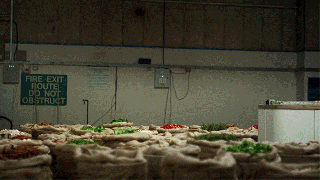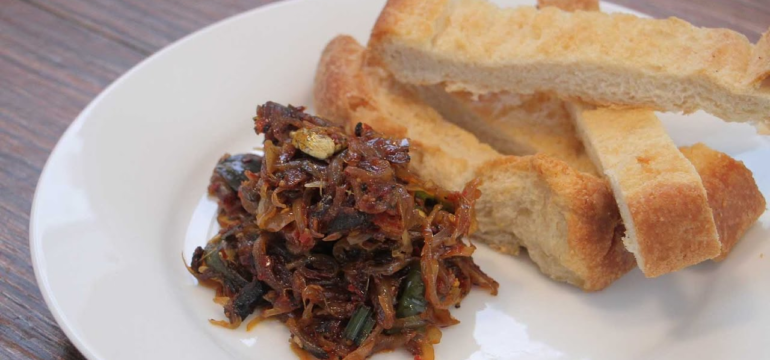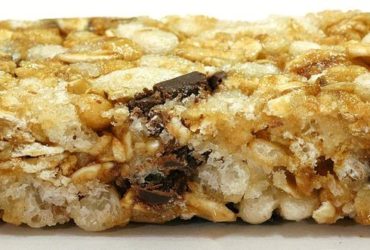BY: PRAVEENA THIRUNATHAN
What would we do in life without the almighty condiment? French fries are not the same without its partner in crime the sweet and tart ketchup, while mustard is a must on any Chicago hot dog. However, even though we love them, I believe that none of these condiments are a match compared to the almighty, the most delicious, and the most flavorful condiment of all: Seeni Sambal!

https://media.giphy.com/media/SAl7lAGGH7Bba/giphy.gif
Since sambal may not be as well known as our friends ketchup or mustard discussed above, we will start with the basics. A sambal is a kind of paste that is mainly made with chilis, with supporting ingredients such as dried shrimp, coconut flakes, curry leaves, or onions. You can find sambal pastes throughout Singapore, Malaysia, Indonesia and Sri Lanka, as the ancient traders of the Indian Ocean would spread not only their wares, but also knowledge and recipes from one culture to the next. A seeni sambal, which I will be focusing on today, is primarily made with onions, caramelized to bring out their sweetness. It’s funny, because when I was young and heard the word for the first time, I thought that it was a dessert because seeni is the Tamil word for sugar, but a seeni sambal is so much more complex than that.

http://i.imgur.com/7pNxR2x.gif
The reason I believe seeni sambal is the best condiment out there is because it combines sweet, umami, and sour tastes together so that they dance gracefully on your tongue. The sambal also contains spiciness (a trigeminal sensation) from the chilies, complimented by wonderful aromas (due to the aromatic compounds) from its many spices. This combination of flavours is what I think makes it so addictingly delicious, but if you haven’t noticed already, Sri Lankan stores are kind of rare to find on this side of the Pacific. So how can you taste this delicious sambal? If you’re lucky enough to live in an area with a large Sri Lankan diaspora (ex. Toronto, NYC, Paris, London, or Zurich), then you can head over to one of the local bakeries or grocery stores and find yourself a jar of this masterpiece easily. Since this isn’t an option for most of you, I’ve adapted a recipe you can make at home, as well as use as a template to explain all the fun chemical reactions that are happening in your pan as you cook your sambal.
Ingredients:
2 tbsp oil
1 inch long cinnamon stick (or 1 tsp cinnamon powder)
2-4 cloves
2-4 green cardamom pods
2-4 curry leaves
2-4 pandan leaves (can leave out if not found)
1 inch knob ginger, grated
2 cloves of garlic, minced
1½ cup of sliced red onions
1 tbsp chili flakes (adjust to taste)
1 tbsp palm sugar (can replace with brown sugar)
50 g of tamarind pulp
Salt
Maldive fish flakes (can replace with katsuobushi, mushroom, or soy sauce for vegetarians)
Directions
- AROMATIC FLAVORS – Heat the oil in a pan on medium heat and add the spices: cinnamon, cloves, cardamom, curry leaves, pandan leaves, ginger, and garlic. Make sure they do not burn as you swirl the pan to shallow fry the aromatics.

https://imgur.com/gallery/57qx67i
The first step in making any Sri Lankan sambal or curry is to heat the spices in oil, and what an important step it is. You see, spices (and herbs) contain various aromatic compounds that give our foods flavour. Cinnamon has cinnamaldehyde, which gives the spice its characteristic hot and spicy flavour, as well as eugenol which is also found in cloves [1]. The minty, floral flavor of cardamom is achieved by a combination of alpha-terpineol and eucalyptol [2], while ginger obtains its pungency from gingerol [3]. Pandan leaves contain 2-acetyl-1-pyrroline [4], and curry leaves (yes, there is such a thing as the curry plant, the scientific name being Murraya koenigii) contain beta-pinene [5]. These flavor compounds are not only diverse, but also hydrophobic, meaning that they’re fat-soluble instead of water-soluble. Thus, by heating up the spices and herbs in our frying oil, we’re extracting all these compounds into the oil itself, so that it can adequately flavor our finished sambal.
However, frying the garlic has a different purpose: to tame the sulfur compounds contained within and change the flavor profile to add a huge punch of savoriness. Onions and garlic are part of the allium family, and both contain sulfur-containing, water soluble chemical compounds (called amino acid sulfoxides) that are precursors to the characteristically sharp aroma of these vegetables. Garlic contains a specific amino acid sulfoxide, called alliin, and the enzyme alliinase, star crossed lovers fatefully kept apart by their positions in the garlic cell [6]. But when garlic is cut (or pounded or smashed), the cells are ruptured. These two lovers can then embrace, and alliinase goes on to catalyze the degradation of alliin to form allicin, the compound that provides garlic with its deliciously potent taste and smell. Meanwhile, onions contain the structurally related isoalliin, which is catalytically degraded by both its own alliinase and a second enzyme, called lachrymatory factor synthase, to form propanethial-S-oxide (which is what happens to make us cry) [7]. Both allicin and propanethial-S-oxide degrade further over time, but by frying the garlic (and the onion later on), we thermally denature these enzymes, leaving alliin and isoalliin intact. Both amino acid sulfoxides possess only minor garlic and onion flavor notes, but pack a major punch of kokumi, or savory flavor, that boosts the flavors of the all other components in the sambal.
- SWEETNESS – Add the onions, lower the heat, and saute them in the pan for a good 15 min, until caramelized. Sprinkle on the sugar about halfway through.

http://s2.quickmeme.com/img/34/346c9901ba9a932f7cf2b7737a56038dd2d3afdda27717b50a0db9361dbfcd58.jpgIn this recipe, the sweetness comes from both the sugars naturally present in the onion, as well as the sugar we add to the sambal. When exposed to high heat, complex sugars such as sucrose are pyrolyzed into their constituent sugars, in this case glucose and fructose [8]. This actually increases sweetness since sucrose has a relative sweetness of 1, but glucose has a sweetness of 0.7 and fructose has a sweetness of 1.8. When you average the sweetness of glucose and fructose, it turns out to be 1.25, and thus, definitely sweeter than sucrose by itself.
Since we’re “caramelizing” onions, you may expect to taste some caramel notes in this sambal, but while there is a small degree of caramelization that occurs, the majority of the browning is caused by the Maillard reaction! The Maillard reaction is where you have a reducing sugar (no, not reduced in calories, but a sugar that can unravel from its ring form into its chain form) reacting with an amino acid (there are plenty to be found in onions), to produce a series of cascading reactions, along with their associated products [9]. This gives a more complex flavor in addition to the sweetness you get by “caramelizing” (or should we say Maillarding) the onions.
- SOURNESS – Take your tamarind pulp and soak it in ¼ cup of boiling water for 5 min. Squeeze out the liquid from the pulp and discard. Pour the tamarind water into the pan and stir well.
While many cuisines around the world use vinegar as a souring agent, Sri Lankan cuisine relies on fruits like lime and tamarind to give their dishes a bit of pucker. Their sourness comes from the organic acids present in their flesh – citric acid in limes and tartaric acid in tamarind [10]. The reason these acids elicit a sour taste in your mouth is because the dissociated hydrogen ions trigger the sour taste receptors on your tongue. The full mechanism is still complex and varies from animal to animal, but we do know that the sour taste of an acid is more correlated to the total number of protons the acid can potentially release (moles of H+), rather than the acidic strength (or pKa) of the organic acid itself. So in fact, a strong acid may be equally sour as a weak acid if both possess the same moles of available protons. In addition, the molar concentration of the acid, other anions in the mixture, and the various physio-chemical properties of organic acids all have a role to play in the perceived sourness of a food [11].Even the sour taste found in organic acids has a different note for each acid. Malic acid is described as green, citric acid is described as fresh, tartaric as hard and succinic acid as salty and bitter [11]. For those budding product developers out there, keep these notes in mind as you formulate your new products and need to decide on which organic acid to add to your product.The next three steps are done all at once. - SPICINESS – Add the chili flakes to the mixture. You may add according to taste.

https://pics.me.me/Facebook-8434ec.png
Add according to taste….but according to who’s taste? Some people can’t handle even the tiniest pinch of chili pepper to their food. Others gobble down fresh jalapenos like they’re candy. What is that compound that makes your mouth overheat and your tongue burn like the surface of the sun? Ding ding ding: it’s CAPSAICIN! [12]
You want to know the best part about this compound? It’s produced by certain plants (like bell peppers) as a defense mechanism to prevent mammals and fungi from eating them.
…We are mammals (in case you forgot that from elementary biology).
We *willingly* eat these plants for their spicy effects.
Think about that for a good while…I’ll wait.In any case, spiciness is often mistaken to be a taste, like sweetness and saltiness. However, capsaicin does not activate the taste bud like sugar or salt would. Instead, when capsaicin is ingested, it binds to the TRVP1 receptor, which sends signals to the brain. This receptor is also triggered by intense heat or abrasion, which means that your brain’s response to the TRVP1 signals (whether induced by abrasion, heat, or spicy food) is “HELP. IT BURNS.” [13] Spiciness is thus classified as a trigeminal sensation, because it activates the trigeminal nerve (which conveys sensations like pain, temperature, touch and position) located in the mouth. Other trigeminal sensations are coolness from menthol (added to many minty gums) and astringency from tannins (found in wine). Our mouth really is sensitive, isn’t it
- SALTINESS – Add salt to the mixture.
Salt is salty. Sounds obvious doesn’t it. Let’s think deeper: salt is composed of the elements sodium and chloride. Is it sodium that activates the taste bud? Or is it chloride? Or is it both? The answer is: sodium! It activates the epithelial sodium channels found in your taste buds, and sends the signal to your brain indicating that you just ate something salty. Other cations in the sodium family can also activate this receptor, like lithium (but it’s too toxic) and potassium (but it’s not as strong as sodium) [14].But is salt really adding a strong salty flavor to this sambal? Every time I eat seeni sambal, I’m more inclined to call it sweet or spicy, rather than salt. So why are we adding salt anyways? In fact, why do we add salt to almost everything we cook, even sweet things like cakes and ice cream?Salt has other functions besides taste. In bread, they serve to control the growth of yeast and to stabilize gluten. In sausages, it enhances protein-protein and protein-fat binding. It’s also an ancient preservative, as heavily salting meat and fish lowers the water activity, which then creates an inhospitable environment for bacteria, yeast and molds. In our case, we’re adding salt to our sambal because we want to enhance the sweetness and sourness that are already present. Salt also has a suppressive effect on bitterness, meaning that the slight bitterness that are from the onions, garlic and tamarind is now mitigated and thus the other flavors will dominate [15]. - UMAMI – Add the maldive fish flakes to the mixture. Once all ingredients have been added, cook for another 5-10 minutes or until the sambal is pleasantly dark brown and soft.

http://punpedia.org/wp-content/uploads/2016/09/life-advice-tuna-fish-9719.jpg
I feel umami is the most misunderstood taste, which is no surprise since it’s also the newest taste to be identified. Umami is a compound word from Japanese, umami meaning delicious and mi meaning taste. The delicious taste, described to have a meaty or savory flavor. The best examples of the umami taste are mushrooms, cured meats, and cheese, and you can add it to foods by adding monosodium glutamate (MSG for short). Umami is triggered by amino acids such as glutamate and compounds such as inosine monophosphate and guanosine monophosphate, which contain the carboxylate anion of glutamate. The anion triggers the receptors mGluR1 and mGluR4 [16] which then signals to the brain that delicious umami taste.
Maldive fish flakes are quite rich in glutamate anions, making them a delicious umami bomb of flavor. In my research for this article, I found out something surprising: that Maldive fish and the Japanese katsuobushi….are actually one and the same! Both are bonito tuna, that has been boiled, smoked, and then sun dried until it becomes a hard block (almost wood-like). Same material, different names. The Maldivians tend to break up the block into small chips and add them to curries, while the Japanese shave the fish into fine flakes for flavor and garnish. Have you ever had okonomiyaki and noticed those light pink flakes on top? That’s katsuobushi. The fermentation process during sun drying allows the inosinic acid to develop, giving the fish the characteristic umami taste [17]. If you’re a strict vegetarian, then you’ll find yourself omitting the Maldive fish flakes and it’s umami-ness. However, you can substitute chopped mushroom or soy sauce to bring back the savoriness that this sambal needs sans meat.
And that’s it! Your sambal is finished! Time to spread it on crackers, or use it a a filling for a bun or sandwich. I hope you’re able to make this sambal at home and find it to be super tasty! In the meantime, I’m going to drive over to Scarborough and pick up 2 tubs of pure deliciousness.
References
1. Bullerman, L. B., F. Y. Lieu, and S. A. Seier. “Inhibition of Growth and Aflatoxin Production by Cinnamon and Clove Oils. Cinnamic Aldehyde and Eugenol [Aspergillus Parasiticus, Spices as Preservatives].” Journal of Food Science (USA), 1977. http://agris.fao.org/agris-search/search.do?recordID=US7729176.
2. Pura Naik, J., L. Jagan Mohan Rao, T. M. Mohan Kumar, and S. R. Sampathu. “Chemical Composition of the Volatile Oil from the Pericarp (Husk) of Large Cardamom (Amomum Subulatum Roxb.).” Flavour and Fragrance Journal 19, no. 5 (2004): 441–44. https://doi.org/10.1002/ffj.1336.
3. Menon, A. Nirmala, K. P. Padmakumari, B. Sankari Kutty, M. A. Sumathikutty, M. M. Sreekumar, and C. Arumugham. “Effects of Processing on the Flavor Compounds of Indian Fresh Ginger (Zingiber Officinale Rose.).” Journal of Essential Oil Research 19, no. 2 (March 1, 2007): 105–9. https://doi.org/10.1080/10412905.2007.9699240.
4. Laksanalamai, V., and S. Ilangantileke. “Comparison of Aroma Compound (2-Acetyl-1-Pyrroline) in Leaves from Pandan (Pandanus Amaryllifolius) and Thai Fragrant Rice (Kaho Dwak Mali-105).” Cereal Chemistry (USA), 1993. http://agris.fao.org/agris-search/search.do?recordID=US9434143.
5. Chowdhury, Jasim Uddin, Mohammad Nazrul Islam Bhuiyan, and Mohammed Yusuf. “Chemical Composition of the Leaf Essential Oils of Murraya Koenigii (L.) Spreng and Murraya Paniculata (L.) Jack.” Bangladesh Journal of Pharmacology 3, no. 2 (May 18, 2008): 59–63. https://doi.org/10.3329/bjp.v3i2.841.
6. Cui, Zheng-Wei, Shi-Ying Xu, and Da-Wen Sun. “Dehydration of Garlic Slices by Combined Microwave-Vacuum and Air Drying.” Drying Technology 21, no. 7 (January 8, 2003): 1173–84. https://doi.org/10.1081/DRT-120023174.
7. Ueda, Yoichi, Takako Tsubuku, and Ryuichi Miyajima. “Composition of Sulfur-Containing Components in Onion and Their Flavor Characters.” Bioscience, Biotechnology, and Biochemistry 58, no. 1 (January 1994): 108–10. https://doi.org/10.1271/bbb.58.108.
8. Johnson, Robert Reiner, E. D. Alford, and Glenn W. Kinzer. “Formation of Sucrose Pyrolysis Products.” Journal of Agricultural and Food Chemistry 17, no. 1 (January 1, 1969): 22–24. https://doi.org/10.1021/jf60161a013.
9. Ajandouz, E.h., L.s. Tchiakpe, F. Dalle Ore, A. Benajiba, and A. Puigserver. “Effects of pH on Caramelization and Maillard Reaction Kinetics in Fructose-Lysine Model Systems.” Journal of Food Science 66, no. 7 (September 1, 2001): 926–31. https://doi.org/10.1111/j.1365-2621.2001.tb08213.x.
10. Caluwé, Emmy De, Kateřina Halamová, and Patrick Van Damme. “Tamarindus Indica L. – A Review of Traditional Uses, Phytochemistry and Pharmacology.” Afrika Focus 23, no. 1 (August 8, 2017). http://ojs.ugent.be/AF/article/view/5039.
11. Da Conceicao Neta, Edith Ramos, Suzanne D. Johanningsmeier, and Roger F. McFeeters. “The Chemistry and Physiology of Sour Taste?A Review.” Journal of Food Science 72, no. 2 (March 2007): R33–38. https://doi.org/10.1111/j.1750-3841.2007.00282.x.
12. Caterina, Michael J., Mark A. Schumacher, Makoto Tominaga, Tobias A. Rosen, Jon D. Levine, and David Julius. “The Capsaicin Receptor: A Heat-Activated Ion Channel in the Pain Pathway.” Nature 389, no. 6653 (October 23, 1997): 816–24. https://doi.org/10.1038/39807.
13. Story, Gina M., and Lillian Cruz-Orengo. “Feel the Burn.” American Scientist 95, no. 4 (2007): 326. https://doi.org/10.1511/2007.66.326.
14. Liem, Djin Gie, Fatemeh Miremadi, and Russell S. J. Keast. “Reducing Sodium in Foods: The Effect on Flavor.” Nutrients 3, no. 6 (June 20, 2011): 694–711. https://doi.org/10.3390/nu3060694.
15. Breslin, P. a. S., and G. K. Beauchamp. “Salt Enhances Flavour by Suppressing Bitterness.” Nature 387, no. 6633 (June 5, 1997): 563–563. https://doi.org/10.1038/42388.
16. Chaudhari, Nirupa, Ana Marie Landin, and Stephen D. Roper. “A Metabotropic Glutamate Receptor Variant Functions as a Taste Receptor.” Nature Neuroscience 3, no. 2 (February 2000): 113–19. https://doi.org/10.1038/72053.
17. Kurihara, Kenzo. “Glutamate: From Discovery as a Food Flavor to Role as a Basic Taste (Umami).” The American Journal of Clinical Nutrition 90, no. 3 (September 1, 2009): 719S–722S. https://doi.org/10.3945/ajcn.2009.27462D.






Leave a Reply